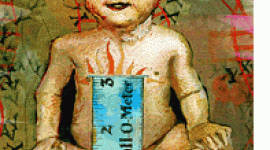Sexual Scientists Question Medical Treatment of Hermaphroditism
note: article written 11-95
The fate of persons born with ambiguous genitals (also called hermaphrodites, or intersexuals) was the focus of debate when sexual scientists from around the world met in San Francisco earlier this month. Before modern medical understanding of endocrinology and advances in surgical techniques, such individuals made their way in the world as best they could. For the past forty years, however, medical technologies have been widely used to force such unruly bodies to conform more closely to male or female shapes. This policy has been implemented almost entirely without public scrutiny, in hospitals throughout the US and other industrialized countries.
In a symposium titled "Genitals, Identity, and Gender," held at the annual convention of the Society for the Scientific Study of Sex, sex researcher Dr. Milton Diamond, of the University of Hawaii Medical School, and psychologist Dr. Suzanne Kessler, of State University of New York at Purchase, found a receptive audience for their criticism of medical treatment of hermaphrodites. Dr. Heino Meyer-Bahlburg, a member of the team which treats hermaphrodites at Columbia University's Presbyterian Hospital in New York, was on hand to offer the clinician's point of view.
Man without a penis-a woman?
Diamond had dramatic news for the assembled sexologists; he presented a follow-up on the famous case of the twin boys. One of these identical twins had lost his penis at age 7 months in a circumcision accident, in 1963. On medical advice, the boy was reassigned as a girl, plastic surgery used to make his genitals appear female, and female hormones administered during adolescence to complete the metamorphosis. The change of sex was facilitated and monitored at Johns Hopkins Hospital, a leading center for medical treatment of hermaphrodites.
In 1973 and 1975, Dr. John Money of Johns Hopkins, a leading expert in pediatric psychoendocrinology and developmental psychology, reported the outcome as favorable. In the ensuing twenty years, the case of the penectomized twin has taken on immense significance; it is cited in numerous elementary psychology, human sexuality, and sociology texts. Most importantly, the case influenced medical thinking about treatment of hermaphroditic infants. Medical texts now recommend that boys born with a penis that is "too small" be reassigned as girls, just as the twin was.Surgeons remove their penises and testes and construct a vagina, and a pediatric endocrinologist administers hormones to facilitate female puberty.
But in fact, according to Diamond's report, the penectomized twin steadfastly refused to grow into a woman, and now lives as an adult man. She didn't feel or act like a girl. She often discarded the estrogen pills which were prescribed at age 12, and she refused additional surgery to deepen the vagina which surgeons had constructed at 17 months of age, despite Hopkins staff's repeated attempts to convince her that life would be impossible without it. "You're not gonna find anybody unless you have vaginal surgery and live as a female," the twin recalls a Hopkins physician telling her.
The twin was not convinced. "These people gotta be pretty shallow, if that's the only thing I've got going for me. That the only reason people get married is because of what's between their legs. If that's all they think of me, I've gotta be a complete loser," the fourteen year old thought.
By age 14, the twin was able to convince her local physicians, if not the specialists at Hopkins, to help her to live as a male once again. He received a mastectomy and a phalloplasty, he began a regimen of male hormones, and he adamantly refused to ever return to Hopkins.
Although the Hopkins staff were aware of the twin's resistance to medical intervention intended to make a woman of him, for nearly two decades they have dismissed questions about the outcome of this important case because the twin was "lost to followup." In discussion following Diamond's presentation, sexologists expressed shock and dismay that they had been allowed continued to teach and to write that the penectomized twin had been successfully transformed into a woman, for twenty years after the care providers involved knew that the experiment had been a tragic failure. Vern Bullough, the distinguished historian, stood to denounce the Hopkins team and John Money as having acted unethically in the matter.
Who has the power to name?
"Medical standards allow penises as short as 2.5 cm to mark maleness, and clitorises as large as 0.9 cm to mark femaleness. Infant genital appendages between 0.9 cm and 2.5 cm are unacceptable." The audience laughed, but Kessler had accurately summarized mainstream medical practice in "managing" infants and children with unusual genitals. At most hospitals, surgeons will remove clitoral tissue from a child born with such in-between genitals, to produce more acceptable female genitals. In others, surgeons transfer tissue from other parts of the body to try to build a larger penis. No one has ever performed studies to determine the long term effect on sexual function of these genital surgeries.
Kessler noted that physicians and parents refer to such genitals as "deformed" before surgery and "corrected" after surgery. In contrast, many of those who have been subjected to surgery label their own genitals as having been "intact" before surgery, and "mutilated" afterward. These individuals are beginning to come together to form an intersex advocacy movement, most notably in the form of the San Francisco-based Intersex Society of North America (ISNA, PO Box 31791 SF CA 94131, ).
Kessler presented a poll of college students' feelings about "corrective" genital surgery. Women were asked to imagine that they had been born with a larger than normal clitoris, and that physicians had recommended surgery to reduce its size. One fourth of the women indicated that they would not have wanted the clitoral reduction surgery under any circumstance; one quarter would have wanted surgery only if the clitoris caused health problems, and the remaining 1/4 would have wanted the size of their clitoris reduced only if the surgery would not have entailed any reduction in pleasurable sensitivity.
Men were asked to imagine that they had been born with a smaller than normal penis, and physicians had recommended reassigning the boy as female and surgically altering the genitals to appear female. All but one man indicated that they would not have wanted surgery under any circumstance. They seem to be saying that they believe they could live as men in our culture, even with tiny penises.
Finally, Kessler presented communications from parents of girls whose clitorises had been deemed "too large" by physicians, and surgically reduced. In some cases, the parents had noticed nothing unusual about their daughters' clitoral size; physicians had to teach the parents that the clitoris was unusual enough to warrant genital surgery.
A clinician's point of view
Meyer-Bahlburg defended the practice of genital surgery on children. Without surgery, he said, they are likely to be rejected by their parents, and teased by other children. He offered the example of one infant whose father was so disturbed by her large clitoris that he attempted to rip it off with his fingers, resulting in a trip to the emergency room. An ISNA representative stood to denounce the father's action as child abuse, which cannot justify surgery on the infant.
Medical intervention has been predicated on the notion that quality of life is possible only for individuals who conform to male or female sex and gender. But in recent years, the possibility of a third gender, of non-conformance, has come to the fore. There are several threads to this discourse. Anthropologists and ethnographers have identified third gender categories in many cultures, such as the Berdache in Native America, the Hijra in India, the Xanith in Oman, and many others. Non-conforming gender roles are also in evidence in the growing transgender movement, which has rebelled against medical policy which offered services to transsexuals only if they conformed adequately to mainstream heterosexual male or female roles.
But most important, Meyer-Bahlburg acknowledged, is the growing intersex advocacy movement. This movement, represented most forcefully by ISNA, is beginning to speak out against the harm of genital surgery and of secrecy and taboo surrounding intersexuality. "I believe that this new third gender philosophy is going to have a beneficial and quite profound effect on medical intersex management, but that it will take quite a while," said Meyer-Bahlburg. In response to a question from the audience, he indicated that he would begin to advocate less surgery for "minor" cases of genital abnormalities.
Bo Laurent, a doctoral student at the Institute for Advanced Study of Human Sexuality in San Francisco, is a consultant to the Intersex Society of North America.
next: Genital Surgery On Intersexed Children
~ all inside intersexuality articles
~ all articles on gender
APA Reference
Staff, H.
(1995, November 1). Sexual Scientists Question Medical Treatment of Hermaphroditism, HealthyPlace. Retrieved
on 2025, December 12 from https://www.healthyplace.com/gender/inside-intersexuality/sexual-scientists-question-medical-treatment-of-hermaphroditism

